with azbil
SPECIAL
- NEW
Special Talk | Koichi Sakai, ESG Fellow, Nikkei BP Intelligence Group & Takayuki Yokota, Director, Representative Corporate Executive Deputy President, Azbil Corporation
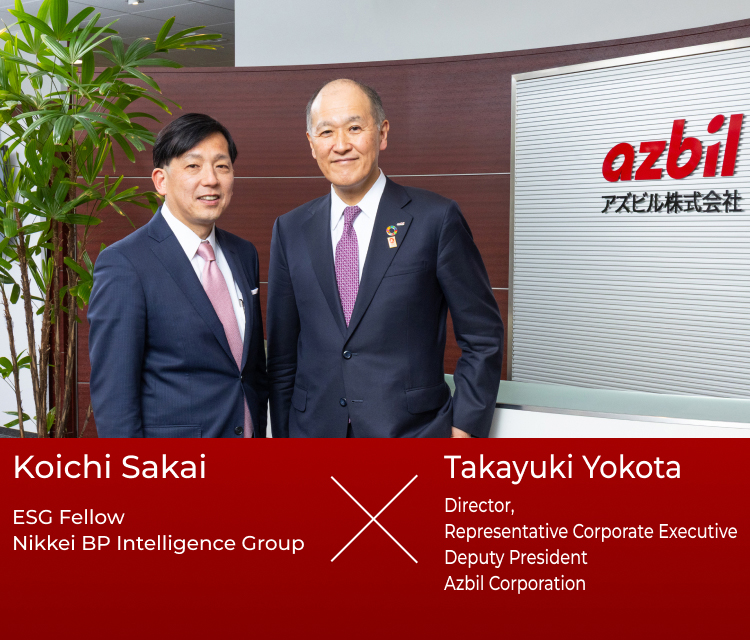
Enhancing the employee stock ownership plan to engage all employees in company management and strengthen human capital
As companies are expected to strengthen their human capital in recent years, Azbil has introduced the Japanese Employee Stock Ownership Plan - Restricted Stock (J-ESOP-RS) and the Trust-Type Employee Shareholding Incentive Plan (E-Ship®). This has helped advance initiatives to increase the enterprise value driven by both employees and the company. As the company aims to engage all employees in corporate management, Koichi Sakai (ESG Fellow, Nikkei BP Intelligence Group), who is an expert on enterprise value enhancement measures and has networked extensively with many corporate executives, and Takayuki Yokota (Director, Representative Corporate Executive Deputy President, Azbil Corporation) exchanged opinions about this topic.
Leveraging company stock to turn employee motivation into fuel for the company
Sakai You have provided solutions to various social issues using measurement and control technologies such as in Building Automation and Advanced Automation businesses. What particularly impresses me is that field-level departments, which directly provide value to customers, and the headquarters team work together to support the sustainable growth of the company. As an economic magazine reporter, I have interviewed numerous domestic manufacturers, where I particularly noticed a mindset gap between the field-level team and the headquarters. For example, while the factory may manage costs with extreme precision down to the unit of one yen or even smaller, the headquarters appears to take a lenient approach to costs. I believe that financial matters, above all, require strict discipline. As a solution, it is essential to establish financial discipline to gain trust in the company itself and the management, which requires enhancing visibility and strengthening governance. Secondly, while monozukuri (manufacturing) is certainly important for employees, they need to gain greater insight into the importance of underlying capital. On that note, company stock plays a significant role. While employees have strong interest in bonuses and raises, company stock fails to attract their attention. I’ve always found this very frustrating. Under these circumstances, you have introduced an incentive plan that is a refined version of the traditional employee stock ownership plan. While introducing the plan itself must have been challenging, I believe it will be even harder to ensure that the employees will recognize its value. What are your thoughts on this?
Yokota As you said, it is crucial to encourage employees to recognize the importance of money as operating capital. To help them gain greater insight, I believe it will be effective to remind employees that they are part of the company through stock ownership. On the other hand, many employees are hesitant about stock ownership as it is still not fully embedded in Japanese culture. However, by owning company stock, employees can see how their hard work helps increase the enterprise value, which, when recognized by the market, drives up the stock price. This allows them to feel a sense of pride and experience financial value and satisfaction as shareholders. I’m hopeful that establishing this system will help gradually increase employees’ motivation, encouraging them to actively participate in corporate activities with greater interest in financial aspects and capital discipline. This is one reason why we have incorporated the incentive plan into our financial and capital strategy and have been buying back our own stock while exploring how best to return this value to our employees.
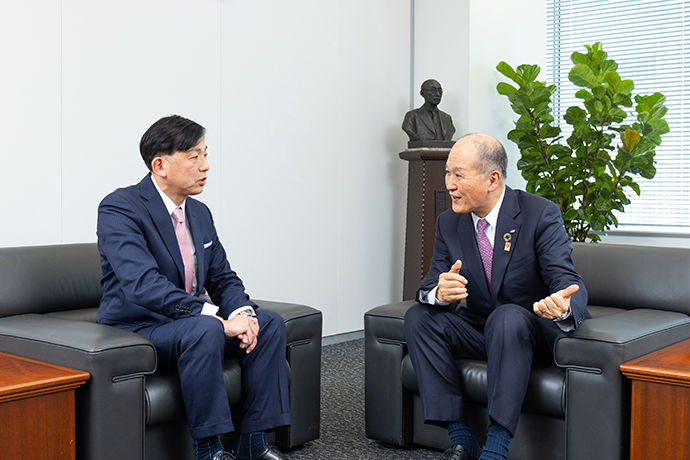
Building employee ownership through the J-ESOP-RS with tangible benefits
SakaiYou have mentioned a system where employees can increase the enterprise value through their own hard work and experience the outcome in the form of compensation. To that end, you have implemented a new employee stock ownership plan. Could you explain it in detail?
Yokota
The first initiative we worked on was the Employee Stock Ownership Plan (J-ESOP [stock grant-type ESOP*1]). In this program, all employees received points each year based on their salary and bonuses and when retiring, they received company shares based on the number of accumulated points. However, this program had two problems. For one thing, since it only provided points until the employees retired, it did not give them a real sense of “owning shares.” Secondly, the plan did not offer an attractive financial incentive because the employees did not receive dividends while in service.
Therefore, we revised the plan, switching to J-ESOP-RS*2, a refined version of J-ESOP, starting in April this year. By providing restricted physical shares rather than points, employees become registered shareholders in their own names, allowing them to exercise voting rights and receive dividends. The revamped system gives employees a sense of ownership, allowing them to grow with the company and promoting employee well-being through engagement.
Sakai I see. By giving a more real sense of owning shares, the new system helps enhance their engagement in company operations and management.
Yokota
Yes. Furthermore, we drastically reformed the employee stock ownership association system which the employees voluntarily participate in, implementing the Trust-Type Employee Shareholding Incentive Plan (E-Ship®*3 [employee stock ownership plan-based ESOP]). Under this system, the company acquires necessary shares from the market in advance, providing them to employees at market price. If the stock price increases, the employees can receive the gains. Of course, being stock, its value can fall. However, employees do not bear the risk of losses from the stock purchase price—the company takes on that risk for them. In other words, this incentive plan only carries the same risk as a typical employee stock ownership association (i.e., potential decline in the market value of shares held), essentially creating an “upside potential without downside risk” mechanism.
In fact, to further expand this system, we implemented a special incentive program in February 2025. As a token of gratitude for employees’ continuous efforts to sustainably drive social development through automation, we gave away 40 shares to each member of the employee stock ownership association. This gesture encouraged other employees to enroll in the association, rapidly increasing the enrollment ratio.
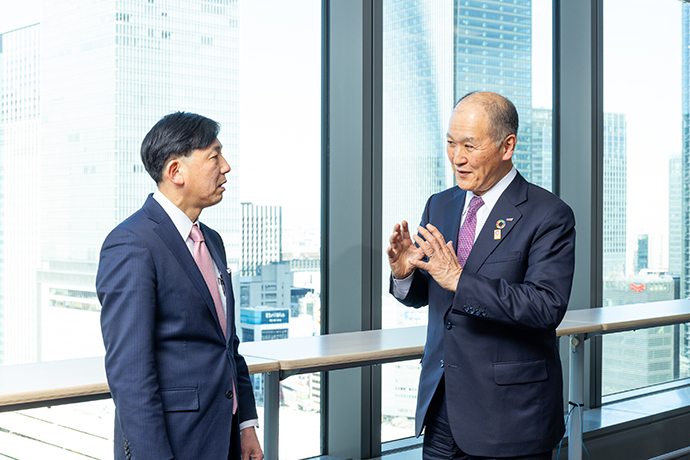
Implementing growth strategies and strengthening human capital by engaging all employees in company management
Sakai These systems have been implemented precisely to promote Zen-in Keiei (company-wide participative management) by giving employees a sense of unity with the company and encouraging them to participate in management as shareholders. For example, in the US, employees with company stock provide their insights at general shareholder meetings. Being an employee and shareholder gives them equal footing with the management. To name another US trend, major automotive and pharmaceutical companies used to create company towns. In these settings, corporations were deeply rooted in local communities, and supported employees’ livelihoods, and employees typically worked under something similar to lifetime employment. The same was true for other major Japanese companies. In recent years, the US’s leading IT companies have once again started to appreciate the value of long-term employment. If employees work diligently, their stock holdings increase and they can also expect the stock price to rise, benefiting them as a result. This approach is becoming popular as it creates growth opportunities for both companies and employees. This growth-oriented strategy will help the company strengthen its human capital.
Yokota
Similarly, Azbil requires a perspective taking into account sustainable growth. As you know, we mainly engage in B2B business, and consistently receive high customer ratings for our products, technologies, services and engineering capabilities. To put it differently, however, our stability may undermine our ability to accommodate changes and openness to trying new things. Given this situation, the new medium-term management plan for FY 2025 to FY 2027 is specifically designed to drive sustainable growth, upholding the idea that co-creation and evolution with society will help us grow.
As another example related to Zen-in Keiei, I also would like to mention our sponsorship of the Expo 2025 Osaka, Kansai, Japan, which is being held in Yumeshima, Osaka. I asked our young employees to envision an exciting future in line with “Designing Future Society for Our Lives,” the expo’s theme, while incorporating their interests and aspirations. Moreover, I hope that they will gain inspiration through creating something new through collaborative exchanges with other companies. I believe that all these initiatives will help foster a sense of participation in management among all employees.
The need for corporate transparency and financial discipline driven by rising foreign investment
Sakai At the same time, I also emphasize strengthening governance to increase the enterprise value. In addition to setting up programs, I also find it essential to establish a management system supporting them.
Yokota The ratio of foreign shareholders has increased over the past decade or so, inevitably requiring us to transition to more transparent and agile management approaches. Following repeated discussions, we decided to transition to a company with a three-committee board structure in 2022. We have strived to enhance management transparency and soundness through executive oversight via the Board of Directors with a majority of outside directors, and through the Nomination, Remuneration, and Audit Committees, each chair served by an outside director.
Sakai I see. So by having you, who is also the CFO, on the board of directors, the company has been able to accelerate management decision-making.
Yokota Yes. Transitioning to a company with a three-committee board structure empowers the corporate executives, but they are held accountable for everything. The board of directors, which oversees management, can dismiss corporate executives at any time. Therefore, the corporate executives need to make decisions with a sense of urgency and responsibility to help drive the business growth and enhance financial discipline.
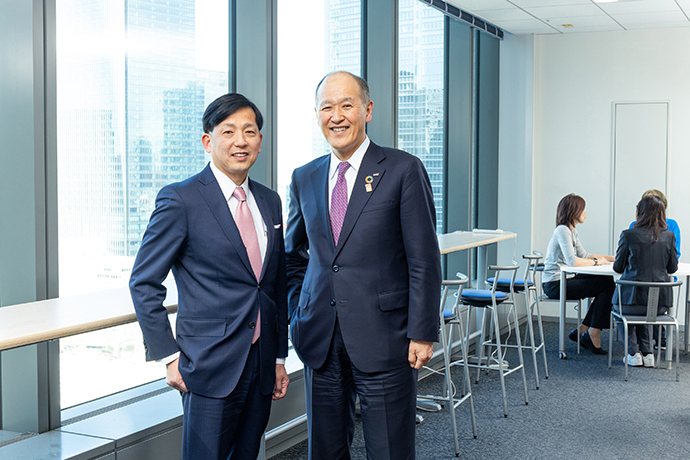
Sakai In your previous job at the financial institution, you were involved in IR activities for many years—I believe your extensive experience has helped you accurately convey the corporate executives’ intentions to each committee’s directors and convince them. In today’s business world, companies are expected to be both creative and disciplined. This expectation applies not only to management, but also to all employees. Under these circumstances, through the employee stock ownership plan, employees will be working to feel a sense of personal growth from one day to the next while maintaining discipline. For example, manufacturers like Azbil have to think beyond merely making good products and shipping them from the factory. If the products do not sell well, they must also consider the resulting warehousing and storage costs and depreciation. This will also expand the scope of work for the factory. In other words, the employees need to be fully aware that their work will eventually affect the balance sheet.
Yokota Indeed, being a shareholder means you have to consider all these things. Employees need to be aware of the impact their work has on the company’s processes, performance and future. This will help increase employee engagement significantly.
Sakai In this sense, the employee stock ownership plan can become the foundation for cultivating a management mindset and developing human resources that will support the company as future executives.
Strengthening talent management and ensuring continuity of human capital
Sakai As you mentioned, the employee stock ownership plan is one of your initiatives to nurture each employee as human capital. Tell me about your other initiatives.
Yokota
As mentioned earlier, our services, maintenance and engineering capabilities are highly recognized by our customers. Employee knowhow and insights are fundamental to our services and capabilities and serve as a source of sustainable growth. As such, we need to preserve and pass them down within the organization, regardless of how times change. Therefore, we focus on company-wide initiatives, including AI utilization, and discuss talent management approaches to strengthen human capital. I believe we need to further visualize which departments need human resources, what kind of talent they need, and how many people they need.
Starting from FY2025, I am personally handling HR and education, I see managing human capital more effectively as my next goal.
Sakai Thank you very much for the very productive discussion today. I’m very much looking forward to your further success.
Yokota It would be wonderful to have your advice in various situations going forward. I appreciate your continued support.
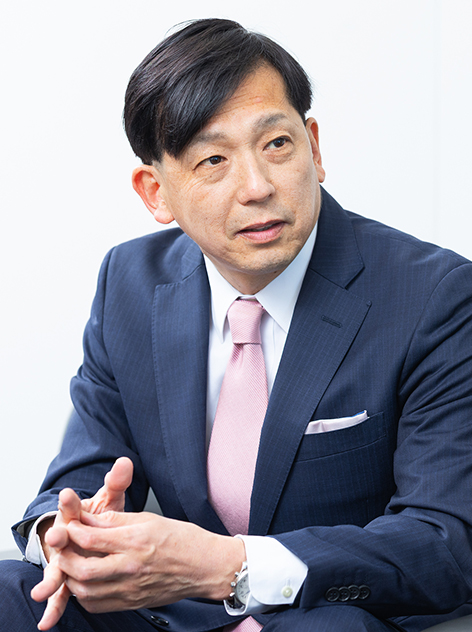
I expect Mr. Yokota to demonstrate strong leadership in the reform by leveraging his extensive experience at the financial institution.
Koichi Sakai
ESG Fellow
Nikkei BP Intelligence Group
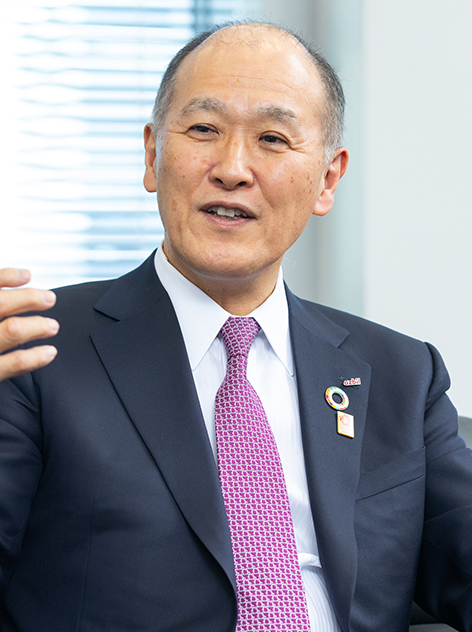
Human capital strategies by reforming the employee stock ownership plan.
The company and employees grow together under common future .
Takayuki Yokota
Director, Representative Corporate Executive
Deputy President
Azbil Corporation
- *1: Employee Stock Ownership Plan (ESOP)
A system in which a company uses its own funds to acquire the company’s shares and grants them to eligible employees as incentives. - *2: Japanese Employee Stock Ownership Plan- Restricted Stock (J-ESOP-RS)
A benefit plan designed to provide incentives for the sustainable enhancement of enterprise value by allocating common shares with transfer restrictions to employees, thereby aligning their perspective with that of shareholders. - *3: Trust-Type Employee Shareholding Incentive Plan (E-Ship®)
This is Japan’s first employee incentive plan that applies the employee stock ownership association system, developed by Nomura Securities Co., Ltd. and Nomura Trust and Banking Co., Ltd., based on the employee stock ownership plan (ESOP) that is popular in the United States. - *This article was translated from the Japanese version of the article published on August 20, 2025.
 Related information
Related information
-

Interview with the CEO
-

Efforts related to the Osaka-Kansai Expo are creating new value
-

Strengthening employee engagement through human capital enhancement measures utilizing the Company's own stock
-

New incentive scheme under the employee stock ownership association plan to foster a sense of participation in management among employees
-

Well-being
-

Notification Regarding Readoption of Trust-Type Employee Shareholding Incentive Plan (E-Ship®)
